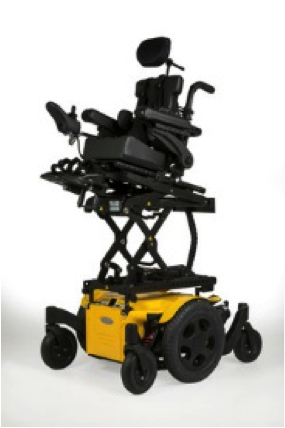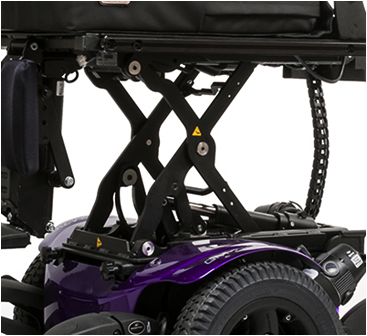Share:
What it is
Seat elevation in a power wheelchair is a lift of the seat pan on the vertical plane, as the picture below illustrates. Seat elevation raises and lowers the height of the seating system, without changing seat to back or seat to floor angles. While seat elevation can be prescribed with other power positioning features, such as power tilt, recline and elevating leg rests, the focus of this month's Clinical Corner article will be solely on power seat elevation.

How it works
An actuator, or motor, raises and lowers the seat pan in response to commands given by the driver of the wheelchair through the input device, such as a joystick. In the photo below, the scissor mechanism raises and lowers the seat pan to the desired height.

Considerations
There are different models of power seat elevation and differences in heights achieved. When selecting the most appropriate device for an individual, consideration should go to the maximum height of the seat elevate function. For example, a 12 inch seat elevation may allow an individual to have greater access to objects in the environment versus a 9 inch seat elevation mechanism.
Because the seat elevate mechanism is added to the wheelchair between the base and the seat pan, the lowest possible seat to floor height may be affected. Therefore, another consideration may be on the lowest possible seat to floor height when power seat elevation is added to a power wheelchair. When fully lowered, how compact is the seat elevation mechanism? For example, will it allow an individual sitting in the wheelchair to get under tables?
Another consideration is the safety of an individual when driving a power wheelchair with the seat fully elevated. When elevated, seat elevation raises the centre of gravity on the wheelchair, which can affect the stability of the wheelchair. The way that we can compare this to everyday objects is to think of a power wheelchair with the seat fully elevated as being like an SUV vehicle and when the seat elevation is in a lower position, the same power wheelchair can be likened to a sedan. In certain conditions, an SUV is more likely than a sedan to roll over due to its higher centre of gravity. Thus, for a power wheelchair user with a seat elevate option, driving habits and driving conditions will have an effect on safety when the centre of gravity is high. Some models may have factory pre-set programming to automatically reduce maximum speed available at highest elevation for safety.
Benefits
There are many functional benefits of seat elevation. In turn, these functional benefits can have physical benefits for the individual.
With seat elevation, an individual is able to reach and access higher levels. This includes things like light switches, clothing rods, and upper shelves and cupboards. Being able to reach higher levels within the home may reduce the need for assistance from family members or personal support workers. In addition, it may minimize the need for some home modifications. Being able to reach higher levels in stores, work, school and other public spaces enables independence.
While being independent in reaching higher levels is a benefit in itself, there is an additional physical, or medical, benefit from using seat elevate to access items more easily. Reaching and lifting from above-shoulder height causes increased strain on the shoulders and upper extremities. By using seat elevate, an individual is able to reach and lift from a height that is below the shoulders, which offers better biomechanical advantage and reduces the risk of injury.
Seat elevation also is beneficial for performing transfers. Sliding board transfers are easier when done from a higher level to a lower level as gravity assists with the transfer. If the bed and wheelchair, for example, are different heights, an individual may have to transfer from a lower level to a higher level, working against gravity with one of the transfers. With the use of a seat elevate option on a power wheelchair, an individual would always be able to position the height of the wheelchair to enable the transfer to be most optimal – from a higher level to a lower level – possibly reducing the risk of strain or injury over the long-term.
Social interaction and communication are other benefits of power seat elevation. When an individual seated in a wheelchair communicates with an individual who is standing, neck extension is required to maintain eye contact. A long conversation may involve prolonged neck extension, which can contribute to pain in the neck and upper back when this is done on a repetitive basis. Think about a noisy environment and the need to get close to our friends to be able to hear what they are saying. Seat elevation allows an individual to communicate on the same level as friends, family and peers.
Another benefit of seat elevation relates to safety and visibility. When crossing streets, driving a power wheelchair in an elevated position may allow an individual to be seen more easily by drivers in vehicles because of the increased stature.
As seat elevation in a power wheelchair is an option that has both physical, functional and social interaction benefits for the individual using it, it is an option that should be considered when prescribing a power wheelchair. While we can see that there are many benefits to seat elevation, unfortunately, this is an option where many provincial funding sources have not caught up in terms of understanding the medical benefits of this option, leading to lack of funding. Non-traditional sources of funding may need to be explored.
References
- Arva, J., Schmeler, M.R., Lange, M.L., Lipka, D., & Rosen, L.E. (2009). RESNA Position on the Application of Seat-Elevating Devices for Wheelchair Users, Assistive Technology, 21(2), 69-72.